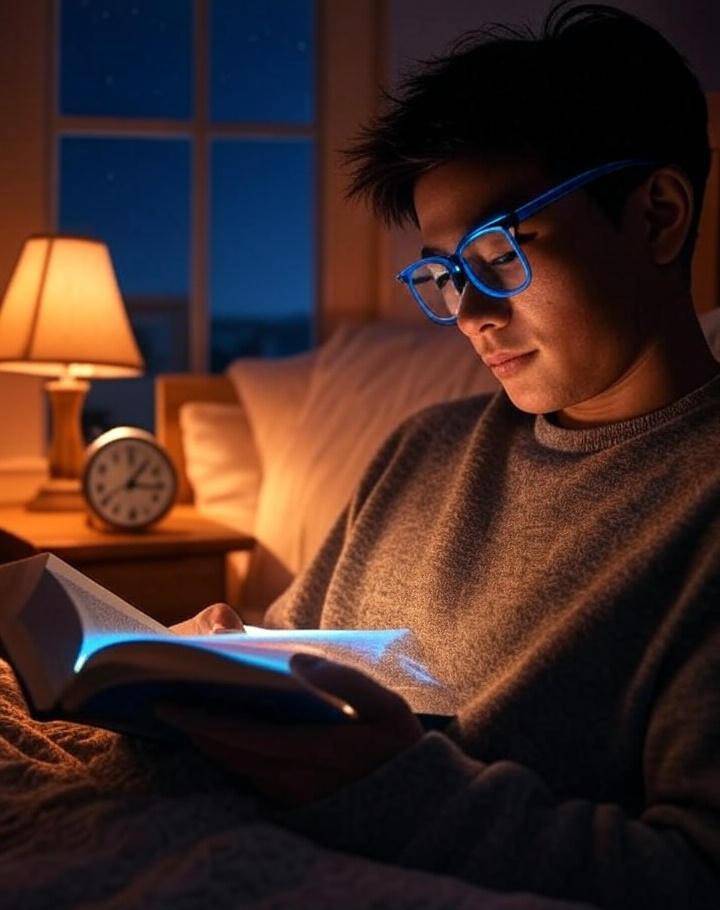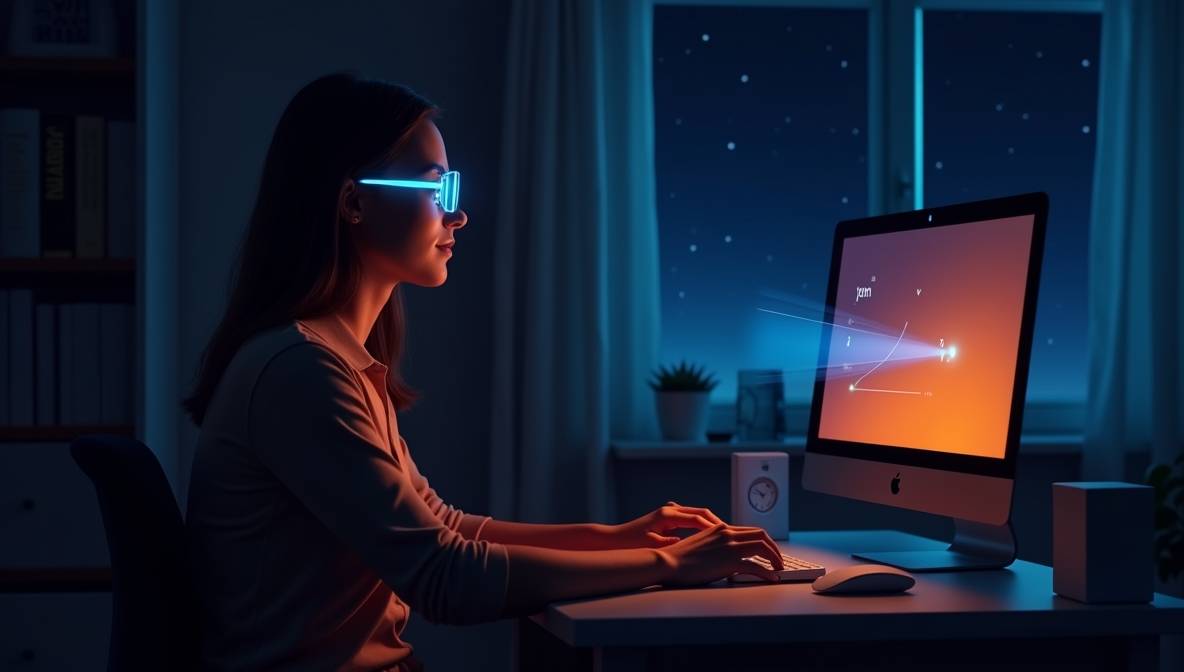Discover how blue light affects your sleep and eye health, and learn effective ways to protect yourself from its potential harms.
Key Points
- Blue light from screens may disrupt sleep by suppressing melatonin, a hormone that regulates the sleep-wake cycle.
- Prolonged exposure to blue light might cause digital eye strain, with symptoms like dry eyes and headaches.
- Some studies suggest a link between blue light and long-term eye damage, but evidence is mixed, and sunlight emits far more blue light than devices.
- Practical steps like using blue light blocking glasses, enabling night mode, and limiting screen time before bed can help mitigate effects.
- Recent research indicates overall light brightness, not just blue light, may significantly impact sleep, sparking some debate.
What is Blue Light?
Blue light is a high-energy visible (HEV) light within the visible spectrum, characterized by short wavelengths (380–500 nanometers) and high energy. It’s naturally emitted by the sun, contributing to the sky’s blue appearance, and plays a key role in regulating our circadian rhythm, boosting alertness, and enhancing mood during the day. However, artificial sources like LED lights, smartphones, tablets, computers, and TVs also emit blue light, raising concerns about its effects when exposure occurs at night.
How Blue Light Affects Sleep
Research suggests that blue light exposure, particularly in the evening, can disrupt sleep by suppressing melatonin production, which signals the body to prepare for rest. This disruption can delay sleep onset, reduce sleep quality, and misalign the circadian rhythm, making you feel alert when you should be winding down. Studies, such as one from the University of Basel, indicate that evening blue light exposure can significantly delay sleep onset and shorten sleep duration. Chronic sleep disruption may increase risks for health issues like obesity, diabetes, and cardiovascular disease.
Blue Light and Eye Health
Blue light’s high energy allows it to penetrate deep into the eye, potentially causing digital eye strain, with symptoms like dry eyes, blurred vision, and headaches. Approximately 59% of American adults report digital eye strain symptoms due to prolonged screen use, according to the Vision Council. There’s also concern about long-term risks, such as age-related macular degeneration (AMD), though the evidence is not conclusive, as sunlight emits significantly more blue light than devices. Children may be more vulnerable due to larger pupils and developing eyes.
Protecting Yourself from Blue Light
Several strategies can help reduce blue light’s impact:
- Blue Light Blocking Glasses: These filter out blue light and may improve sleep quality and reduce eye strain by 10–23%, per UC Davis Health.
- Night Mode: Most devices offer settings to reduce blue light emission, especially useful in the evening.
- 20-20-20 Rule: Every 20 minutes, look at something 20 feet away for 20 seconds to reduce eye strain.
- Limit Screen Time: Avoid screens 1–2 hours before bed to support melatonin production.
- Environmental Adjustments: Use warm-colored lights and dim screens at night to promote relaxation.
Understanding Blue Light

What is Blue Light?
Blue light is part of the visible light spectrum, with wavelengths between 380 and 500 nanometers, making it the shortest and most energetic. It’s naturally abundant in sunlight, which helps regulate our circadian rhythm by suppressing melatonin during the day, keeping us alert and focused. Artificial sources, including LED lights, fluorescent bulbs, and digital screens (smartphones, tablets, computers, and TVs), also emit blue light, though in smaller amounts compared to the sun. The widespread use of these devices has raised concerns about their impact on health, particularly when used extensively at night.
Sources of Blue Light
- Natural Sources: The sun is the primary source, delivering blue light that supports daytime alertness and mood. It’s essential for children’s eye development and vision, as noted by UC Davis Health.
- Artificial Sources: Common sources include LED and fluorescent lights, computer monitors, smartphones, tablets, and LED TVs. Americans spend an average of 7 hours daily on electronic devices, according to WebMD, increasing exposure to artificial blue light.
During the day, blue light enhances cognitive function and mood, but evening exposure can interfere with sleep and potentially strain eyes. For more on maintaining overall health in a digital age, check out Healthy Habits to Boost Your Immune System.
The Impact of Blue Light on Sleep
Melatonin Suppression
Melatonin, produced by the pineal gland, is critical for signaling bedtime. Blue light exposure in the evening can suppress melatonin release, tricking the brain into thinking it’s daytime. A University of Toronto study found that individuals wearing blue light-blocking glasses had similar melatonin levels to those in dim light, suggesting these glasses can mitigate suppression. Reduced melatonin can lead to difficulty falling asleep and lower sleep quality.
Circadian Rhythm Disruption
The circadian rhythm, our internal 24-hour clock, relies on light cues to regulate sleep and wakefulness. Evening blue light exposure can delay this rhythm, causing insomnia or poor sleep. The Sleep Foundation notes that most Americans use devices within an hour of bedtime, contributing to unsatisfactory sleep. Chronic misalignment may lead to metabolic disorders and mental health issues like depression, as highlighted in Depression and Sleep.
Health Consequences
Disrupted sleep from blue light exposure is linked to serious health risks. Research from UC Davis Health associates it with increased risks of type 2 diabetes, heart disease, cancer, and cognitive dysfunction. Poor sleep also affects mood, productivity, and overall well-being, making it critical to manage evening screen time. For related health insights, see Stress and Diabetes.
| Health Impact | Description | Source |
|---|---|---|
| Type 2 Diabetes | Disrupted circadian rhythms may increase insulin resistance. | UC Davis Health |
| Heart Disease | Poor sleep quality linked to cardiovascular issues. | UC Davis Health |
| Mental Health | Chronic sleep disruption may contribute to depression. | Sleep Foundation |
The Effects of Blue Light on Eyes
Digital Eye Strain
Prolonged screen time often leads to digital eye strain, affecting 27–35% of Americans, per the Vision Council. Symptoms include dry eyes, blurred vision, headaches, and neck or shoulder pain, largely due to reduced blinking rates. Blue light’s high energy may exacerbate visual fatigue, making breaks and proper screen settings essential. For more on eye health, explore Understanding Glaucoma: Causes, Symptoms, and Treatment.
Potential Long-Term Risks
Some studies suggest that blue light’s ability to penetrate the retina could contribute to age-related macular degeneration (AMD), cataracts, or other eye conditions. However, the American Academy of Ophthalmology notes that digital devices emit far less blue light than sunlight, and conclusive evidence of permanent damage is lacking. Still, caution is warranted, especially for long-term exposure.
Children and Blue Light
Children are more susceptible to blue light effects due to larger pupils and developing eyes, which allow more light penetration. A study cited by the Sleep Foundation found that evening light exposure suppresses melatonin twice as much in children compared to adults. Parents should monitor screen time to protect young eyes and sleep patterns.
| Eye Condition | Potential Cause | Risk Level |
|---|---|---|
| Digital Eye Strain | Reduced blinking, blue light exposure | High (59% of adults affected) |
| Age-Related Macular Degeneration | Chronic blue light exposure | Low (inconclusive evidence) |
| Dry Eye | Reduced blinking during screen use | Moderate to High |
How to Protect Your Eyes and Sleep from Blue Light
Blue Light Blocking Glasses
These glasses filter out blue light, reducing eye strain by 10–23% and improving sleep quality, according to UC Davis Health. A study cited by Physiopedia showed that wearing them 2 hours before bed for a week improved sleep duration and satisfaction. They’re especially useful for night shift workers or those with insomnia.
Night Mode and Screen Filters
Most devices offer “night mode” settings that reduce blue light emission by shifting to warmer tones. Screen protectors designed to block blue light are another option. These adjustments can minimize melatonin suppression and eye strain without compromising usability.
20-20-20 Rule
To combat eye strain, follow the 20-20-20 rule: every 20 minutes, look at an object 20 feet away for 20 seconds. This relaxes eye muscles and encourages blinking, reducing dryness and fatigue.
Limit Screen Time Before Bed
Avoid screens 1–2 hours before bedtime to allow melatonin production to resume. Instead, try relaxing activities like reading a physical book or practicing meditation. For additional sleep tips, see Better Sleep: Why It’s Important for Your Health.
Environmental Adjustments
Use warm-colored bulbs (red or orange) at night to minimize blue light exposure. Dimming screens and controlling glare also help. The Sleep Foundation recommends red or orange lamps for bedtime reading to maintain drowsiness.
Daytime Natural Light Exposure
Exposure to natural light during the day strengthens circadian rhythms, making evening blue light less disruptive. Spending time outdoors can enhance sleep quality and overall health, as discussed in The Power of Fitness.
| Protection Method | Benefit | Effectiveness |
|---|---|---|
| Blue Light Blocking Glasses | Reduces eye strain, improves sleep | High (10–23% strain reduction) |
| Night Mode | Minimizes melatonin suppression | Moderate to High |
| 20-20-20 Rule | Reduces eye strain | High |
| Screen Time Limits | Supports melatonin production | High |
Debunking Myths and Recent Research
Recent studies have sparked debate about blue light’s impact. A University of Basel study published in Nature Human Behaviour suggests that overall light intensity, not just blue light, significantly affects melatonin suppression and sleep. This challenges the focus on blue light alone, suggesting that dimming screens or using warmer lighting may be equally effective. The American Academy of Ophthalmology also notes that while blue light contributes to eye strain, there’s no definitive evidence it causes permanent eye damage from digital devices. These findings encourage a balanced approach to managing light exposure.
Final Thoughts
Blue light is a double-edged sword: beneficial during the day for alertness and mood, but potentially disruptive at night. By adopting strategies like blue light blocking glasses, night mode, and screen time limits, you can protect your sleep and eye health. Staying informed about ongoing research helps you make practical choices in our screen-heavy world. For more health insights, explore 5 Diet Tips for Belly Fat.







